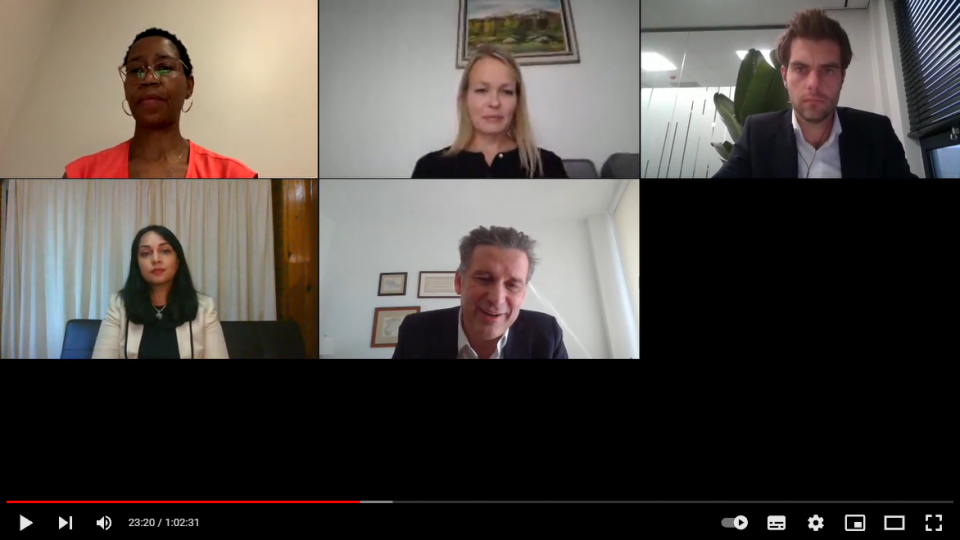Why benchmarking works: one company’s experience

Listen to Andres Peñate, Global Vice President of Regulatory and Public Affairs at AB InBev speak about the company’s journey to improve its human rights practices and disclosures. Peñate explains how being benchmarked by our Corporate Human Rights Benchmark is helping the company in its quest to fulfil its responsibility to respect human rights, as set out by the UN Guiding Principles on Business and Human Rights (UNGPs).
These comments were made on 23 September 2020, at an online event we hosted in the context of the 2020 UNGA SDG Action Zone, titled ‘Corporate Transparency, Social Transformation and the SDGs’.
Below is a partial transcript, which has been edited for brevity.

Partial transcript
We now live in a world in which business – big business in particular – has a role to play with human rights. But a few years ago, this was not the case; a few years ago, there was huge resistance from the business community – especially large companies – to even admit that human rights was in the realm of its activities.
All this changed with the turn of the century: the UN played a key role, and so did some large companies, in listening to the UN. The first thing was the creation of the UN Global Compact, which invited companies to join and benefit from the exercise of being benchmarked and belonging to this community. It requested an explicit and public commitment for respecting human rights. AB Inbev was one of the first companies who joined the Global Compact in 2005. We joined because we shared the belief that there is no conflict of interest between the cause of human rights or the cause of business. It’s impossible for business to prosper and survive in failed societies, and for a society to thrive it must respect human rights.
Then the UN came with the Human Rights Guidelines for Business, which was a significant achievement because we now had a framework to help us to develop policies. It clarified the role of business, and how it differed from the role of government. We incorporated all this into our polices, and it even percolated into our contracts with suppliers, because we have a powerful value chain. What is written in our contracts is as important as law, because it shapes the behaviour of our suppliers. We thought we were doing great, until 2016, with the Corporate Human Rights Benchmark.
What we love about the SDGs is that it has targets. These numbers are the lingo that we speak in business.
The results came, and they were dreadful. We came with a 9.4% score – out of 100! That was a shock. Our immediate reaction? “There must be something wrong with the benchmark!” We sat down with the Corporate Human Rights Benchmark team. Obviously, I wasn’t a happy person in that meeting, but we learned about the metrics, and that there were key elements missing. There were fundamental gaps, and all these gaps were about transparency: publishing our policies, publishing our clauses related to human rights. Very fundamental things. After the meeting, we asked ourselves, “how come we haven’t been doing this before?”
The second year we made a ‘huge improvement’: we moved from 9.4 to something like 17. What went wrong?! We went back and began to see that there were more gaps. It was essential to develop a way of managing risk, or applying a risk mentality that you apply in so many aspects of business, to human rights; so that you can not only respect human rights, but also prevent issues. It was a revelation.
Once you have numbers, you have metrics. Then you also have a benchmark, i.e. you know who’s doing better than you. The Corporate Human Rights Benchmark provided us with a feedback loop for continuous improvement.
The metrics are very important, because things that you don’t measure, you don’t manage. But what’s even more important than the metrics is the conversations that the metrics allow you to have. There are two types of conversations: conversations that you have externally, with people that know how to improve on these metrics, i.e. other companies, NGOs. And internal conversations: conversations with other parts of the business, that speak metrics.
It’s not enough to have intentions, and it’s not enough to have policies – you need benchmarks!
It was these two types of conversations that catapulted our score to 36% in the next benchmark iteration. We moved from being in the bottom five [of the benchmarked companies] to the top thirty. What this ranking shows is that even the companies that have the right intent can do much better by paying attention to the metrics.
We became more humble. We now know the size of our gap and we believe that moving from 9% to 36% is significant. Going from being in the bottom 5 to the top thirty is an achievement, a sign that we’re on the right track, but we have to recognise that there’s more to do. That’s the beauty of the benchmark.
A similar conversation is now going on with the [Sustainable Development Goals] – stewarding the companies, making sure that companies are here to stay, to produce jobs and add value; to make the people working for them proud, and improving the world. Everybody agrees with this idea. It’s not enough to have intentions, and it’s not enough to have policies – you need benchmarks!
What we love at AB InBev about the SDGs is that it has targets. These numbers are the lingo that we speak in business.
My learning from the slow path that I described with human rights from 2005 to 2020, is that we need to do it much faster with the SDGs. We don’t have the luxury of 15 years to do this.
Benchmarks are also key to continue making progress when money is scarce. They show where the priority needs to be and where your resources are going to have the most impact. It gives you priorities and allows you to be more efficient.

